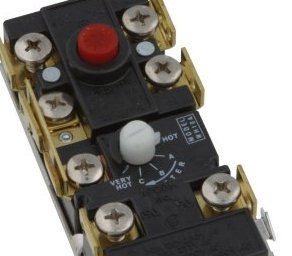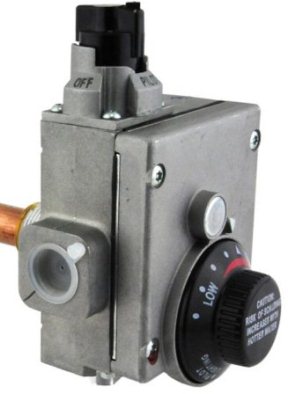- Home
- Water Tank Heater
- How to adjust the temperature on a water heater
How to Adjust the Temperature on a Water Heater: Instructions
A step-by-step guide on how to adjust the temperature on a water heaters with storage tanks.
Discover safe and optimal temperature settings and learn to properly operate the thermostat on both gas and electric models.
Understand how proper temperature adjustment can protect you and your family from scalding hot water and help prevent element failure.
 Gas control valve and thermostat
Gas control valve and thermostatOne of the main reasons for regulating the temperature of hot water from water heaters is to prevent scalding burns. Additionally, this practice contributes to reducing high energy bills.
It's important to note that, according to the American Burn Association, approximately 21,000 children annually sustain injuries from hot water taps.
What is the safe temperature setting for water heaters?
Most gas and electric water heaters come equipped with an adjustable manual thermostat, allowing users to control and regulate the tank's water temperature. Typically, these heaters are designed to produce hot water ranging from approximately 80 F to 160 F, with the capability to reach higher temperatures in commercial settings. It's interesting to note that water heaters are usually factory-set to a 'safe' or optimal temperature of 120-125 F.
Furthermore, it's important to remember that different applications require different temperature settings. For example, a bath or shower typically calls for about 120 F, whereas laundry and dishwashing might need temperatures ranging from 120 to 140 F.
The following list illustrates how the temperature and exposure time relate to the risk of burns on an adult body:
- 120 F - more than 5 minutes
- 125 F - 2 minutes
- 130 F - 30 seconds
- 140 F - less than 5 seconds
- 150 F - 1.5 seconds before the burn occurs
The risk of scalding burns varies depending on the exposure time and the individual's age. Children and seniors are particularly vulnerable, so it's advisable to either adjust the thermostat temperature or install the mixing valves (also known as temperature limiting valves) for their protection..
These anti-scald devices are quite useful, as they mix cold and hot water to achieve a safer temperature at the point of use. Some plumbing codes and manufacturers even require the installation of such valves.
For residential homes, lower temperatures are recommended for safety and energy efficiency. However, if the temperature is set too low, the tank may rapidly deplete its hot water supply.
Worse still, it could lead to the growth of Legionella bacteria inside the tank.
Legionella is commonly found in water sources like hot tubs, showers, and swimming pools. It takes about half an hour to die at 140 F, while the safe threshold is around 158 F.
Using a mixing valve allows you to maintain a higher thermostat setting while still ensuring safe water temperatures at the point of use.
Common problems occured due to improperly adjusted water temperature
If the water from your heater is excessively hot and unresponsive to adjustments, the thermostat is likely at fault. In electric water heaters, a red reset button is designed to activate if the thermostat fails to cut off power to the heating element.
Should both the thermostat and reset button malfunction, the heating element will continue to draw power, heating the water to potentially unsafe levels. Signs of this issue may include steam emitting from the Temperature and Pressure Relief (TPR) valve or audible boiling sounds inside the tank.
If the temperature exceeds the safe level, the temperature and pressure relief valve (TPR) will open, causing water to drip or flow out as a safety measure.
Another issue to be aware of is excessive sediment buildup on the heating elements. This can lead to them working inefficiently, corroding, overheating, and ultimately burning out.
Adjusting the temperature on an electric water heater
 Electric thermostat
Electric thermostatWhen changing the temperature of hot water on electric water heaters, follow these steps:
- Before you make any calibration, measure the temperature of hot water at the tap. The goal is to adjust the temperature to approximately 120 F.
- Turn OFF the electricity to the heater. Do not try to regulate the temperature with the power ON.
- In order to access the thermostats, both lower and upper ones, remove the access panels and foam insulation that covers the thermostats.
- Use the flat screwdriver and rotate an adjusting knob to the desired temperature.
- Once the thermostat is set to the desired temperature, put the access panel and foam back and resume the power.
- Wait for a few hours, so the temperature of hot water inside the tank stabilizes, and measure the temperature at the faucet. If the temperature of 120 F is your goal, mark the setting on the thermostat with the marker.
- Find Plumbers In Your Area -
How to adjust the temperature on a gas water heater
 Robertshaw gas valve
Robertshaw gas valveRegulating the temperature on gas water heaters is simpler than on electric units because it doesn't require any tools, and accessing the thermostat is straightforward.
The thermostat is part of the gas control valve that is located at the bottom of the heater. Most water heater manufacturers use gas valves from companies like White Rodgers, Honeywell, and Robert Shaw.
The thermostats on the gas valves are usually set to the lowest temperature setting.
To increase the temperature on water heaters with the White Rodgers valves, you should turn the dial counterclockwise while on Robertshaw and Honeywell valves is opposite, clockwise to increase, counterclockwise to decrease.
Most of the temperature dials are marked with the " Warm" (120 F) and "Hot" (160 F) and have the "optimal temperature" (130 F) mark. Some gas valves, such as Honeywell, have the "Vacation" mode (85 F) to adjust the temperature when the water heater is not used for an extended period.
If the hot water temperature exceeds the maximum allowed (usually 180 F) and to prevent overheating, a high-temperature limit switch or ECO (part of the gas control valve) activates, shutting down the whole unit.
Lower thermostat settings on water heaters are OK during low demand periods and as long as it satisfies your needs, or during the absence. It will reduce the energy loss and prevent the tank from freezing during cold weather. Turning the water heater temperature down also means reduced scale sediments and less corrosion.
Note: Reducing the temperature by 10 degrees Fahrenheit can result in energy savings of approximately 3% to 5%
Conclusion
In conclusion, the process of adjusting the temperature on a water heater is essential for ensuring safety, energy efficiency, and optimal performance. Whether you have a gas or electric unit, understanding the thermostat settings and their impact on water temperature is crucial.
By following the recommended guidelines for different applications and considering factors like the risk of scalding burns and energy savings, you can make informed decisions about your water heater temperature settings.
The best setting could vary from one user to another. However, if we want to follow expert advice, such as the U.S. Environmental Protection Agency (EPA), the temperature of 120°F will keep bacteria at bay, ensuring safe water while avoiding scalding incidents. Additionally, higher water temperatures can lead to faster mineral deposits, ultimately resulting in higher energy bills.
Regular maintenance, such as removing sediment buildup and monitoring thermostat functionality, is also key to the heater's long-term reliability. Ultimately, finding the right balance between comfort and safety while conserving energy is the goal of temperature adjustment on water heaters.
Related
- Check out the main parts in water heaters
- Anode rod - How to replace and install
- Dip tube - Replacing and installation tips
- Drain valve - What is it, how it works and installation tips
- Heating elements - Testing, installation, problems and solution
- Installing an insulation blanket
- TPR valve - How to replace
- Expansion tank - What is it, how does it work and installation
- Home
- Water Tank Heater
- How to adjust the temperature on a water heater
